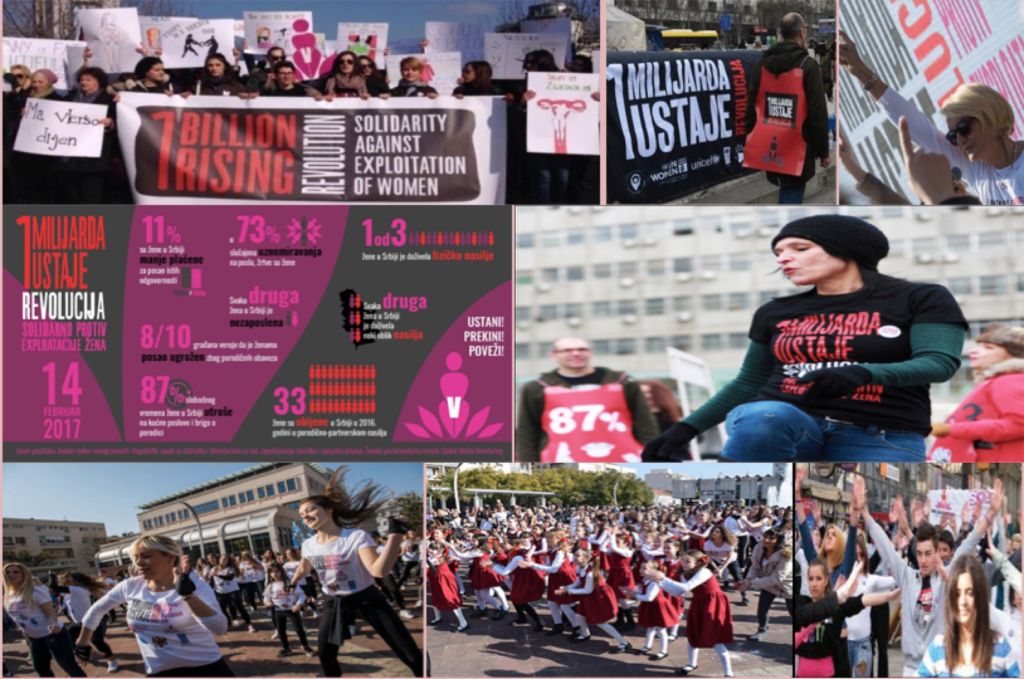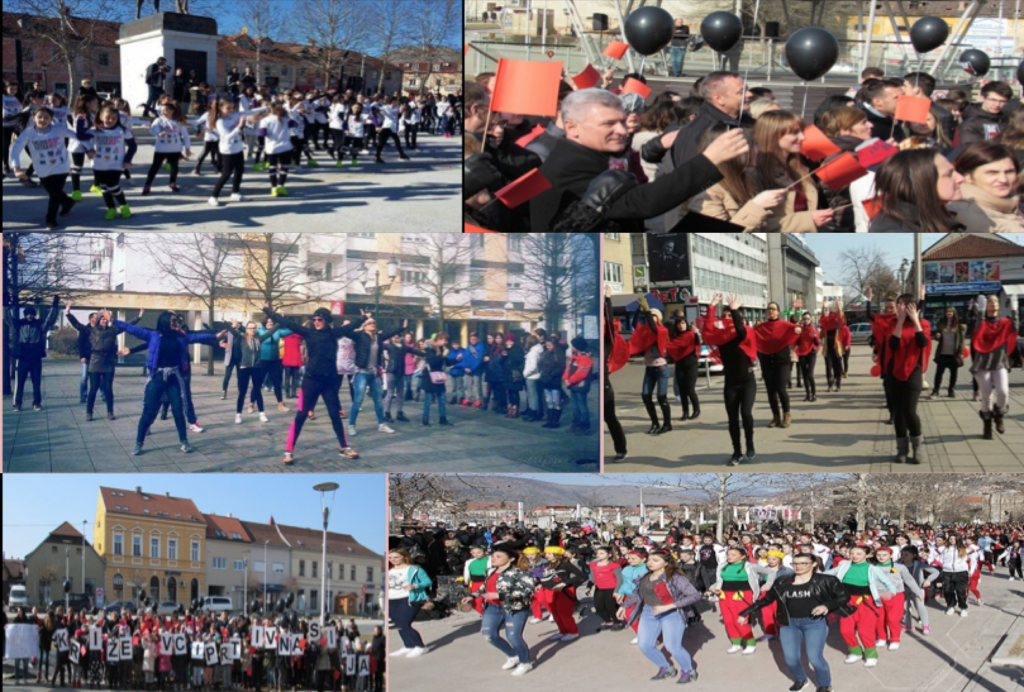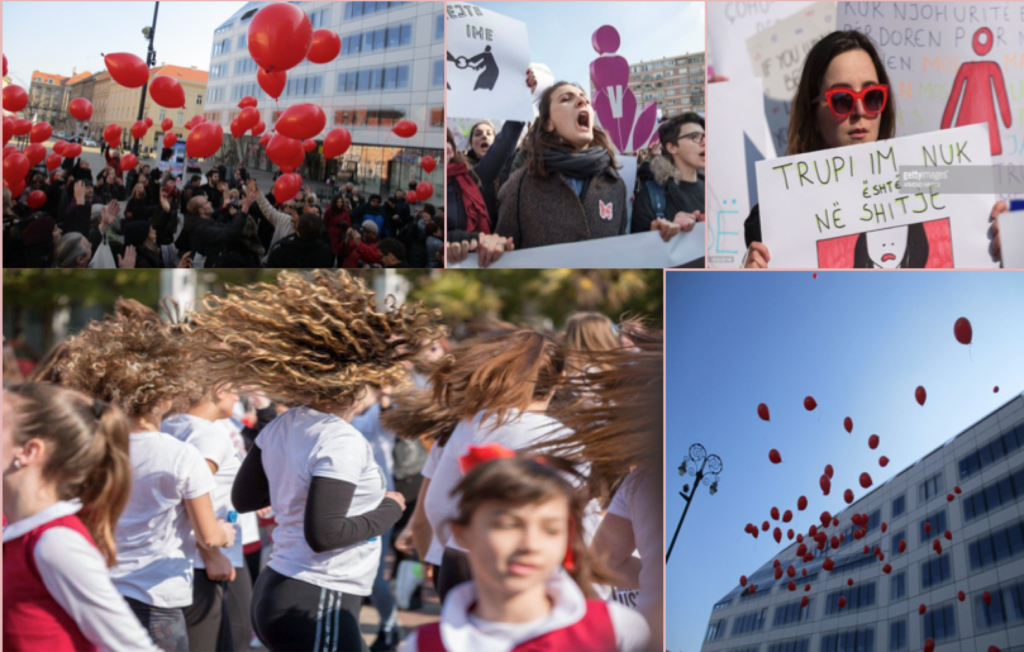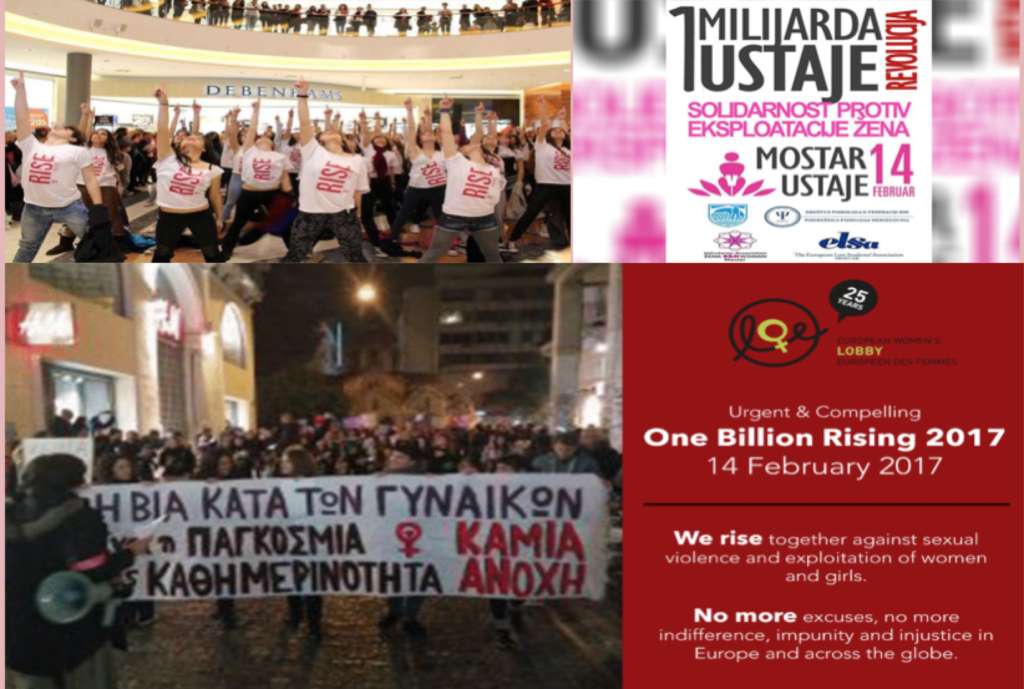“Exploitation of women” and “solidarity” were the overall themes promoted in the whole region. Specific focus was chosen by particular local campaigns, ranging from the exploitation of minority women (for example, in Croatia – women with disabilities, in Cyprus – migrant women, in Hungary – homeless women, among others) to the struggle for women’s working rights or women’s sexual and reproductive rights. These were also the focus of OBR events organized on March 8 or OBR groups and activists who joined other March 8 protests.
This years’ focus was also how to involve/include more women workers, underprivileged women, activists, members of different workers’ unions – to mobilize more women. Still, majority of the events focused on demands to implement laws and measures on preventing VAW – which would reduce exploitation, economic dependence and unequal positions of women in the society. Demands also included implementing domestic laws or the Istanbul Convention to combat VAW – such as in Serbia, Bosnia and Herzegovina, Montenegro, Kosovo, Croatia – because women wanted to show direct links between VAW and exploitation, as well as highlight the lack of respect to laws and policies that might protect women.

Campaigns often tackled all levels – in some places with better results (depending on the focus). Advocacy work – to promote legislative change or adoption of new laws proved to be successful. For example in Croatia – the government promised to ratify the Istanbul Convention – The Council of Europe Convention on preventing and combating violence against women and domestic violence until the end of 2017. In Kosovo OBR pressured the government to prepare the law on the rights of women victims of sexual violence in war (I participated at the conference last November, where together with the Women’s Network, Kosovo OBR 2017 was announced, as well as in Cyprus where women demanded active participation in the new peace negotiations). In many places education was used as regular ‘tool’ to sensitize women and men, as well as officials (training for police and judicial officials) around VAW. The campaign started in September, using every opportunity to promote OBR events and continued until the main OBR events in February and March. These included seminars, workshops, conferences as places to advocate for women’s rights and promote OBR activities.
Main events on February 14th were organized in different public spaces, main squares, shopping malls, streets, local government premises, schools… and always served as consciousness awareness raising events and were well covered by media.

The media loves OBR (because of the messages, dance, colors…). Groups organizing OBR have established good relationships with the media and some journalists have became great OBR spokespersons (many of them served as spokespersons for the events). OBR events were presented in main mainstream media, internet portals, and on social media, etc.
Challenges and obstacles differed from country to country – depending on their local capacities and often institutional support. The countries who have had more experience in organizing OBR from the very beginning have established good relationships with different stakeholders and the media who supported risings, and in that way have overcome obstacles. It is still a challenge to promote OBR’s goals in the institutions but finding allies was crucial for the campaign.
It is important that the team/teams start organizing early enough to ‘predict’ possible challenges and obstacles. Those who have organized OBR for the last 4 years have developed ‘strategies’ on how to organize the campaign.
Strategies include:
 Many creative and artistic ideas were implemented this year. Creative ideas included different OBR ‘advertising’ – like posters and videos – with public figures talking (from singers, politicians, often ombudspersons for human rights, to sportsmen). The ‘Break the chain’ flash dance is often used as a core or ‘culmination’ of the event. Some places had their own dance choreography, and some dances used costumes to express political advocacy. Many places used the OBR space to present alternative dance groups, like youth dancing or performing, including kids from kindergartens.
Many creative and artistic ideas were implemented this year. Creative ideas included different OBR ‘advertising’ – like posters and videos – with public figures talking (from singers, politicians, often ombudspersons for human rights, to sportsmen). The ‘Break the chain’ flash dance is often used as a core or ‘culmination’ of the event. Some places had their own dance choreography, and some dances used costumes to express political advocacy. Many places used the OBR space to present alternative dance groups, like youth dancing or performing, including kids from kindergartens.
OBR Zagreb in Croatia had singers and poetry performed by women with disabilities in wheel chairs. The Ombudsperson joined me to hold a seminar to empower women with disabilities (a few years ago “The Vagina Monologues” with women with disabilities was performed – and it had great impact on women with disabilities).
Refugee women from Syria and Iraq in Croatia attended an artistic workshop supported by OBR groups/members.
In Hungary the OBR event was held in a tango bar, and were focused on all sorts of dances, not only the OBR flash mob dance.
From the OBR Hungary report:
“We used this opportunity to raise funds through an art raffle and a fundraising campaign organized by our volunteers. The money went into three women NGO-s, including the Hungarian Women’s Lobby, one NGO working in the frontline with substance abused teenage mothers, most of who are prostitutes (Józan Babák Association = Sober babes).
“The party lasted late and was a unique mix of homeless women, feminist academics, social workers, men, the American expat community in Budapest and journalists.” (OBR Hungary)
In the small town of Čakovec, Croatia women held public actions, circulating to women around the town paper roses (previously made at workshops with young women) with an SOS help line number and a leaflet with a haiku poem “Broken isn’t bad’ which included graphics.
The Vagina Monologues was often performed during the campaign (in Bosnia and Herzegovina, Serbia, Montenegro and Croatia). Different poetry events and modern dance/performances were also organized.
Some of the creative ideas included dancing with umbrellas, women and men dancing showing statistics on VAW, lanterns and balloons set free at the end of the events, among many others.
Over these five years different grassroots organizations participated. These included women’s groups and networks, associations of women/people with disabilities, ethnic minority groups (Roma in particular), migrant women and refugee women (Cyprus, Croatia), LGBTIQ groups and networks (in Zagreb at Split, Belgrade’s Pride events, ), sections of women’s trade union organizations (in Cyprus and Croatia), green movement activists, artists – individual artists and groups – and in all countries (Bulgaria, Bosnia and Herzegovina, Kosovo, Croatia, Serbia) – video messages and theater performances.

In many countries dance groups were leading ‘Break the Chain’ with audiences. Joining the OBR events were members of sports clubs and individuals (with a focus on men and within the sports world of hockey, rugby and football – like what is happening in Croatia), local and national governments (including governmental officials, ministers and presidents), ombudspersons for human rights, international organizations representatives (often financial supporters, like UNDP in Montenegro, Serbia).
The youth participated through organized events in schools (Bosnia and Herzegovina, Croatia) and being part of the public events, including kids from kindergartens (speaking, reading poetry, dancing).
Men participated in the campaigns by sending messages via videos and pictures. Public figures participated by reading parts of the Istanbul Convention – in the campaign to ratify it (Croatia, Serbia). The Montenegro Government held their OBR event at the Parliament.
Some feedback from participants:
“A timely and creative protest with the specific aim of raising awareness. In past years we’ve seen hundreds of men and women attending the event, and we’re hoping in the future to expand to all cities across the island”. Maria (Cyprus)
“OBR is a reminder not to lose solidarity, empathy and civil courage in addressing violence” (Igo, Kosova).
“When we are supporting victims, we stand in solidarity with women victims of violence and we want to bring perpetrators to justice”. (Miloš, Serbia)
“When I dance I feel free. When I dance with women and for women I feel powerful” (Sanja, Croatia)
The region is very diverse, so the developments of the OBR campaign in the last five years in each place has also been diverse and unique. Here are a few examples: Hungary (in Central Europe), Cyprus (in south-east Europe), and then the Balkans with their experience of recent war(s), are transitioning into new democracies. They each have different local contexts, current political situations (worsening in Hungary and in the Balkans), women’s organizing and cross sectoral cooperation. What unifies all of those countries is the backlash on women’s rights in the last five years despite women’s struggles (due to the ultra right wings politics prevailing in Europe).
Overall – all local OBR campaigns progressed from year to year in sensitizing their own communities on VAW issues- media wise and general audience wise. Local campaigns continued to pressure local governments to implement strategies and laws to combat VAW.
2017 is the Year on VAW in Europe, and many local OBR campaigns focused towards the goal of ratification (by the EU countries) of the Istanbul Convention, to obtain common EU directive on VAW thus strengthening the five year campaign.
In the first two years of OBR the flash dance was the main artistic peak of the campaign’s event on February 14th and this mobilized different groups, dance groups and audiences. In the last few years the artistic side of the campaign has really developed – growing into concerts, poetry, theatre performances. But dance remains the ‘trade mark’ of the campaign, involving more and more people each year. Cross sectoral cooperation has also strengthened over the years. And the OBR campaigns have supported more different movements/events. We have also seen more men be involved, and more institutional support be given.
Europe continues to rise because women and girls face more and more issues. The biggest issue in many countries and the whole region is the backlash on women’s rights, especially on women’s sexual and reproductive rights, under the influence of the Church and ultra rightwing organizations (‘imported’ from the US) – and more restrictive laws on the right to abortion (recently banned in Macedonia and almost in Croatia).
Also, the whole region is reducing policies to end VAW, impunity is still prevalent or growing (VAW is treated as a misdemeanor); and there is a lack of support services for women (insufficient number of shelters and no secure financial support for autonomous women’s shelters), etc.
There is no harmonized policy on VAW in Europe (many countries did not ratify the Istanbul Convention) and therefore women are not equally protected. The European Women’s Lobby, as the biggest EU women’s network, proposed that the next OBR support the idea to demand equal access to policies/laws/justice globally, on the basis of examples of huge discrepancies from one country to another. The Balkan region would support this idea, since women often, when doing advocacy work, compare situation and solutions in the neighboring countries trying to implement best practices.
The theme of solidarity against the exploitation of women was very well accepted – women and men understood the true meaning of solidarity (due to the experience of living in a socialist system, and worker’s organizing). Solidarity, reclaimed as both word and action, was recognized as a much needed act of civic engagement, more than ever. This time against exploitation of women.
Many of the groups and networks who have regularly organized OBR want to continue with the campaign, since OBR has become part of their programs/agenda in the struggle for combating VAW at a local level. OBR is an opportunity to maintain the struggle against VAW on the political agenda, and very useful in advocacy work – not just across the Balkan region, but also the EU, and a tool to demand the ratification of the Istanbul Convention. It has a special impact in mobilizing diverse groups, women and men, to sensitize audiences.
Also for us, OBR gives a sense of belonging, a sense of solidarity, and of being part of a global movement against VAW.
Next year we would love to think about Rising for equality – since we live in a more and more divided and unequal world. The theme is broad enough that women can choose their own focus locally – for example: demanding equality at work, equal pay, equality in institutions (concerning VAW), equal rights to live in the world without poverty, war, violence…
To Rise for a world without violence.
To Rise for one world (One world, one struggle!)
Zagreb, Croatia
Kosovo
Brod, Croatia
Mostar, Bosnia and Herzegovina